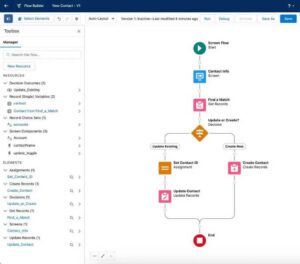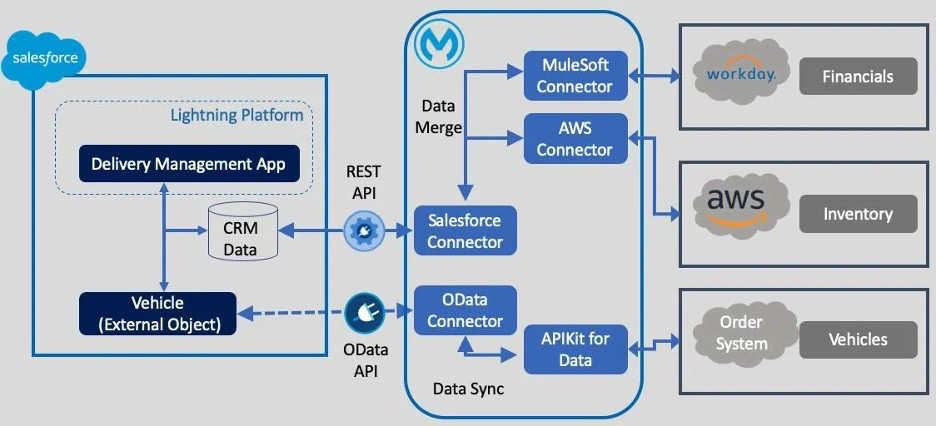Salesforce optimization is an important part of realizing the maximum ROI on your implementation. In this blog, we cover four key areas of optimization, including effective data management, automation for improved performance, customization and configuration to align with business needs, and seamless integration with other systems.
Whether you are already using Salesforce or are only beginning your journey, it’s essential to ensure you realize its full potential to benefit your organization. The difference between a successful Salesforce implementation and one that falls short comes down to applying – or failing to apply – the focused attention and strategic modifications that can drive significant improvements.
In other words, we’re talking about Salesforce optimization, which involves configuring and refining Salesforce to more closely align with an organization’s particular needs and workflows. It also involves customization, automation, establishing data precision, and business systems integration.
Salesforce optimization is integral to a successful implementation, as it enhances the system and empowers the workforce to harness its full potential. By optimizing Salesforce, organizations can prevent data silos, reduce inefficiencies, ensure accurate reporting, and improve customer service. This leads to better decision-making and streamlined operations, and ultimately, boosts sales and revenue.
In this blog, we’ll look at four key strategies to help optimize your Salesforce use and a few best practices to follow during that process. Let’s start with the data.
Effective Data Management for Salesforce Optimization
Getting the data right is one of the overarching imperatives of any Salesforce implementation, one that involves diligent planning and execution.
“Garbage in, garbage out” may be a cliché, but it’s true. Inaccurate data doesn’t become useful just because you enter it into a system – even a robust one like Salesforce. Reliable data, which lies at the core of your Salesforce implementation, can drive business growth, but poor data quality can create all sorts of headaches and undermine trust in your implementation.
Many common data problems – such as duplicate records, incorrect information, missing data, and disorganized entries – can affect your Salesforce system and result in inaccurate reporting and operational difficulties.
Data-First Design
Effective data management begins during the planning stage of your implementation. That’s when you must clearly define what data you will collect when you gather it, and who will be responsible for entering and maintaining it. While we live in an era where information is highly valued, it’s often better to focus on having accurate data rather than simply collecting large amounts of it.
Distinguishing between required and optional fields for each process stage is crucial to ensuring quality data entry without overwhelming users. Salesforce already requires some fields, such as those below:
- Account: The account name is a required field. Optional fields may include billing details, phone, website, and Salesforce ID.
- Users: Required fields include username, first name, last name, email, and locale.
- Contacts: Required fields include first name, gender, and home phone.
You can set other fields, including custom ones, to “required” within your Salesforce implementation based on your specific needs.
It’s important to thoughtfully determine which fields your business requires – mandating too many fields can lead to users hastily and inaccurately filling them out, resulting in incorrect initial data. Users might enter incorrect data just to proceed to the next step, further compromising your system.
Customizable page layouts in Salesforce also play a key role in the data collection process. They control which fields are visible, read-only, or mandatory and manage the organization of these fields on object record pages.
A well-designed page layout prioritizes the most relevant fields by placing them at the top, ensuring they are easily completed. You can tailor layouts to specific users, allowing for precise control over what they can view or edit. They also enable custom additions or deletions of user interface elements, such as fields, to ensure the layout aligns with business needs.
When used correctly, validation rules, dropdown menus, and multiple-choice options often benefit users by restricting the values they can input into a field. This makes data entry more accurate and can improve downstream reporting. Establishing system security also contributes to data quality. By carefully assigning access levels, you can avoid the chaos that may result from granting “edit” access to too many users.
Securing customer data is necessary for compliance with regulations such as GDPR and HIPAA. Implementing secure single sign-on (SSO) technologies and multifactor authentication can help protect your system from cyber threats.
Ongoing Data Management
Data management doesn’t end once you enter information into your system. It’s an ongoing and important process for your Salesforce optimization that requires your regular attention – including periodic data audits, whether manual or automated.
Reports on “Last Modified Date” can identify where information is likely outdated, and reports showing the percentage of blank fields can highlight areas needing attention. Salesforce’s Duplicate Management features can also help identify and eliminate duplicate records.
AI-based tools have taken data management to a new level. Machine learning algorithms can analyze massive amounts of data, detect patterns, and automatically identify and resolve data quality concerns. The Einstein AI platform from Salesforce also has automated capability to match data, merge records, and enrich data.
This AI solution cuts down on labor-intensive work and makes the data more accurate. We’ll go into more depth about automation in optimization later in this blog.
It’s also essential to establish data governance processes. Since effective data governance sets data-use standards and processes for your organization, it ensures that the data is always secure, regularly managed, and trustworthy. Good data governance can improve business outcomes.
Notable data enrichment tools like ZoomInfo, Clearbit, and FullContact can validate and supplement existing data – and, hence, deliver continuous data improvement – by integrating directly with your Salesforce instance.
What’s frequently at the heart of data management integrity in Salesforce implementations and optimizations also has a hand-in-glove relationship with delivering business performance excellence – automation.
Use Automation for Optimal Salesforce Performance
Automation optimizes your Salesforce implementation by transforming it from a simple information storage system into an actionable, integrated application that drives sales and operational success. Salesforce Flow has replaced older tools like Workflow Rules and Process Builder to become the go-to solution for process automation within the platform.
That’s because Salesforce Flow can handle all but the most complex automations within a point-and-click interface, so admins can create sophisticated processes without needing to write Apex code. Moreover, Salesforce Flow can define and automate customer journeys, too.

Image source: https://trailhead.salesforce.com/content/learn/modules/flow-basics/go-with-the-flow-th
Some of the easiest processes to automate within core Salesforce include field updates, lead routing, alerts, and emails. Businesses using Salesforce CPQ (Configure Price Quote), for example, can automate pricing and quote approvals based on a set of rules and standards, with specific users notified when those rules are not met.
Companies using Salesforce Marketing Cloud can use automation throughout a predefined customer journey to send emails, customize messaging, or follow up on purchases.
If the relevant information is available within Salesforce, there are few limits to the sales, marketing, and customer service processes that you can automate on the platform. In fact, automation is a key capability of Salesforce.
In addition to Salesforce Flow, other automation tools within the Salesforce suite include formulas, validation rules, quick actions, escalation, auto-response rules, and Apex code. Regardless of the tools you choose, using Salesforce’s automation capabilities can increase your organization’s overall efficiency and maximize the platform’s benefits for your users.
Process automation is an expression of just how versatile Salesforce is. You can take that versatility to the nth degree when you optimize Salesforce’s power to create bespoke solutions that custom-fit all aspects of your operations.
Unlock Salesforce’s Full Potential Through Customization and Configuration
Salesforce’s out-of-the-box functionality effectively manages sales, marketing, and service processes, but its true potential is unlocked through customization and configuration. Both approaches – configuration and customization – allow you to tailor the system to your organization’s needs.
Configuration, typically handled by an admin without the need for coding, involves adjusting settings, features, and workflows within Salesforce. Customization, on the other hand, requires code-level changes to modify or add new components, providing more advanced and specialized solutions.
Customization and configuration are complementary, and many implementations use both to tailor a solution that best fits the organizational needs.
Quick Configuration Changes for Maximum Impact
Configuration is the easiest way to tailor Salesforce to your organization’s requirements. You can configure Salesforce for your organization through simple actions, such as branding and using custom URLs, which you can complete during the initial setup to ensure Salesforce visually aligns with your technology suite.
You can also create customized homepages — either as the org default or for specific apps or profiles — to ensure that users are presented with the most relevant and useful information as soon as they log in. For example, homepages can highlight important leads or opportunities or display performance metrics over time. These and other Salesforce customization features deliver singular user experiences.
And while Salesforce has standard objects and fields available out of the box, you can easily rename these to align more closely with your organization’s conventions. When a standard object or field doesn’t fit a need, you can create custom objects and fields. One specific example of this is using Salesforce to track a job recruitment process. In this case, you can create a custom object to contain applicant information.
You can name this custom object “Applicant”, and it could contain custom fields like “Applicant Name”, “Current Job Title”, and “Source”. Likewise, you can define a new Path to track the recruitment process associated with a new role.

Image source: https://trailhead.salesforce.com/content/learn/modules/lex_customization/lex_customization_custom_objects
You can also customize reporting for specific organizational requirements. Deploying custom – rather than standard – reports and dashboards can reveal the critical metrics and actionable insights that lead to data-driven decisions.
That’s especially true for departments that are given personalized dashboards containing data pertaining to their functions. AI-powered Einstein Analytics integration equips you with predictive insights and the ability to forecast trends and detect potentially troublesome issues before they emerge.
Customizing Salesforce with Apex, Visualforce Interfaces, and Low-Code Apps Takes Your System to the Next Level
The Salesforce platform also allows more customization if you need to move beyond what is available through configurations. Apex development, Lightning Components, and Visualforce are key tools available to Salesforce developers to further the customization and automation of the platform.
Apex is a powerful programming language within Salesforce that allows developers to create complex customizations and automate business processes. Here are some key things Apex can do within Salesforce:
- Custom Business Logic: Apex allows you to implement custom business logic beyond what you can achieve through point-and-click tools like flows. This can include custom calculations, validations and multistep processes.
- Automating Processes: Apex can automate business processes such as updating records, sending emails, and generating tasks when certain conditions are met. It’s often used for more complex automation scenarios that Salesforce Flow can’t handle.
- Custom Web Services and APIs: You can use Apex to create custom REST and SOAP APIs, enabling Salesforce to interact with external systems, send and receive data, and integrate with other platforms.
- Triggers: Apex is often used to write triggers that automatically execute code before or after certain database operations, such as creating, updating, or deleting records. This allows for real-time automation and data manipulation.
- Custom Schedulers and Batch Processing: Apex enables the creation of scheduled jobs to run large-scale or time-consuming processes, like data cleanups or sending regular updates, through batch Apex or scheduled Apex.
- Manipulating Data Across Multiple Objects: With Apex, you can manipulate records from different objects (both standard and custom) in a single transaction, making it easy to perform complex operations involving multiple datasets.
- Custom Email Services: Apex allows you to set up custom email services that process incoming emails and perform actions like creating records or sending notifications based on the email’s content.
Lightning Components and Visualforce are two additional frameworks you can use in conjunction with Apex to customize your implementation further. Lightning Components are a powerful tool for building highly customized, responsive and reusable user interfaces in Salesforce.
They provide a modern development approach, enhancing user experience, enabling dynamic data interactions, and integrating seamlessly with the Salesforce platform’s broader capabilities.
Visualforce is an older Salesforce framework used to build custom user interfaces and pages for web applications on the platform. It allows developers to create fully customized UIs beyond the standard Salesforce interface by combining HTML, CSS, and JavaScript with powerful Salesforce-specific components and server-side logic.
While customizations can provide users with highly specific, specialized solutions, there are some important considerations to keep in mind. Customization creates increased complexity, not only for users who may already recognize the standard Salesforce interface but also for admins who need to keep the system running.
Additionally, customizations involving code (Apex, Visualforce, or Lightning Components) require ongoing maintenance. This includes fixing bugs, updating for compatibility with new Salesforce releases, and ensuring that custom features remain functional as business processes evolve.
Tap Into Seamless Integration for Enhanced Efficiency
While Salesforce is a powerful tool on its own, you fully realize the real power of technology when all your systems and data work together seamlessly — and that’s where integrations come in.
Integrations allow you to connect Salesforce with other applications or data sources, streamlining internal or external processes and enabling you to use external data within your Salesforce implementation. Integrations can be one-way (inbound or outbound) or bidirectional, depending on your requirements.
Integrating Salesforce with other systems can help you avoid manual steps. Two examples – an integration from Sales Cloud to an accounting system and sending a web lead to Salesforce – bear that out. In the first case, automatically pushing customer details from Salesforce to the accounting software makes it unnecessary to manually re-enter customer information for invoices.
Second, by submitting a lead form on a website instead of manually, the data automatically transfers to Salesforce as a new lead record, so there’s much less chance of making data entry errors.
Not only is automating the Salesforce data integration much more efficient than manually entering data into Salesforce from another system. It also avoids errors from retyping existing information. Automatically pulling data from one system into Salesforce makes it much less likely that users will commit typos, misinterpret data, or select incorrect data.
Because automation defines clear data mapping between systems, it prevents information mismatches by ensuring that data is moved into the correct fields in Salesforce.
Integrations can also connect workflow processes between systems. Consider, for example, a cash-to-order process that starts in Salesforce. The user adds the details of the quote to Salesforce, where it is approved before being fulfilled through the connected ERP system.
The ERP system can then send that data back into Salesforce, where a customer service rep using Service Cloud can respond to customer inquiries about the specific details of a fulfilled order.
Simply put, Salesforce integration automates data synchronization across systems and, as a result, streamlines data processes. It kills two birds with one stone by eliminating time-consuming manual data entry and significantly reducing the risk of errors.
Reporting is a common use case for integrations, especially when consolidating data from various sources to create multi-faceted dashboards. You can either bring data into Salesforce for reporting or use Salesforce data in an external reporting tool or data lake.
Another frequent use case is when multiple systems are involved in a process. Integrating these systems provides a more seamless and less error-prone experience for users.
Not all data needs to reside within Salesforce. Instead of importing data into Salesforce to establish it as the “source of truth,” you can expose external data to Salesforce, allowing you to reference it without the overhead of managing the data within Salesforce itself.
Salesforce offers a range of tools for integrating your org, from no-code/low-code options like MuleSoft Composer and Flow to developer tools like Apex and API platforms. If you’re new to integrations, start with the no-code/low-code options or work with a developer to design your internal data connections and processes.

Image source: https://trailhead.salesforce.com/content/learn/modules/connectors-for-data-integration/unlock-external-data-to-build-connected-experiences
Bringing It All Together
It’s crucial to optimize your Salesforce implementation to unlock its full potential and drive business success. Whether you are starting your Salesforce journey or looking to enhance an existing system, focusing on key areas like data management, automation, customization, and integration can make a significant impact.
To transform Salesforce into a powerful asset, prioritize accurate and reliable data, use automation tools like Salesforce Flow, and tailor the platform to your organization’s specific needs through customization and integration.
With proper optimization, Salesforce will not only streamline your operations but also provide valuable insights that support growth and efficiency. Continuous refinement and maintenance of your Salesforce implementation will maximize your return on investment and empower your team to achieve their goals more effectively.
You can begin to take advantage of Salesforces’s features in a matter of days, and we are here to help. We are happy to assist with customization, solutions and change management. Let’s Talk


